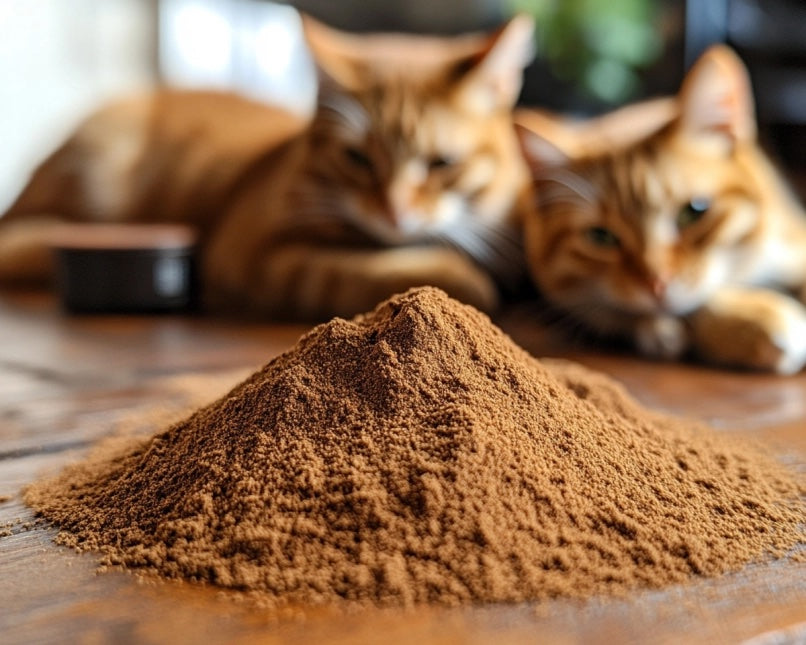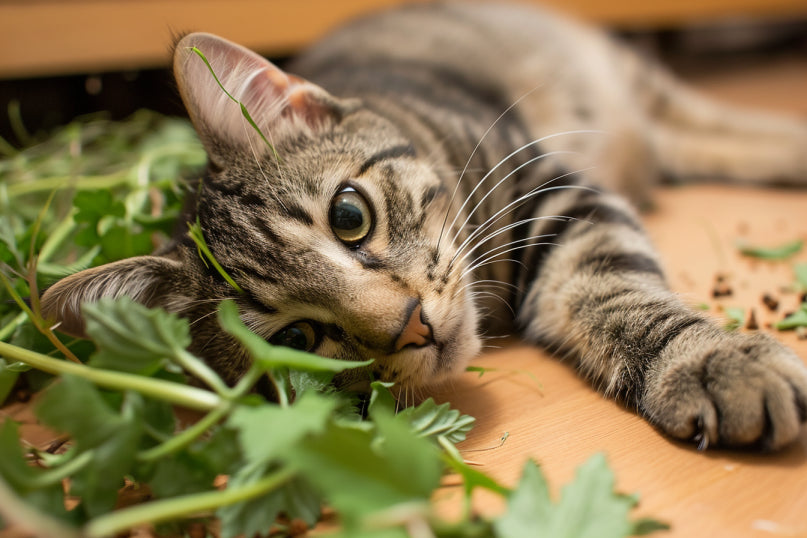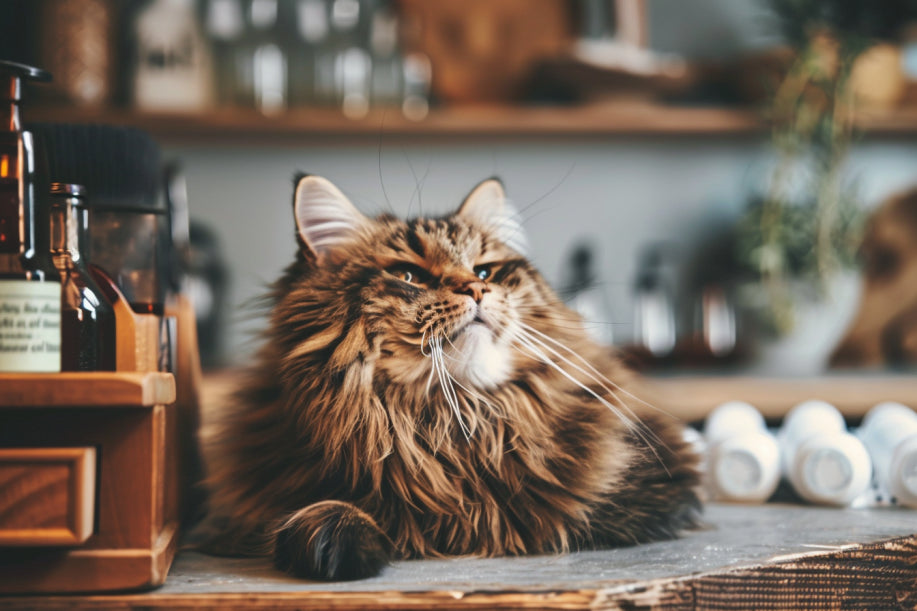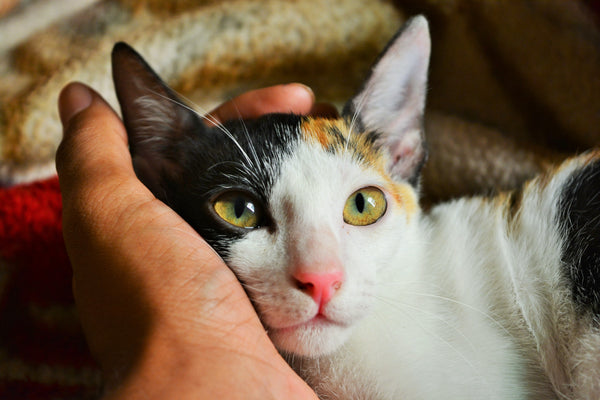
Updated October 2021
Speak LOLcat?
But wish you had a secret decoder guide to your cat's body language?
Psstt...you're about to become a cat whisper.
We sat down with Marilyn Krieger, The Cat Coach and the author of Naughty No More, to learn how to speak cat.
The Tail: A Barometer of Mood
While your cat communicates with his whole body, one part, in particular, tells it all — the tail. When dogs slowly sweep their tails side to side, they're happy. When it comes to cats' tail signs, the matters are much more complex. (What did you expect from your feline overlords?)

Position: High. If your cat’s tail is sticking straight up, he’s confident and content. If its tip twitches, it means he's incredibly happy.
Position: curved like a question mark. Take a break from your daily to-dos to play with your cat if you notice a curve in his tail. This tail sign signals that he’s ready to explore and play.
Position: tucked away. When something makes your cat nervous, like a new family member or environment, he’ll tuck his tail between his legs. It’s a sign of fear and submission.
Position: puffed up. Although it looks hilarious and adorable at the same time, a puffy tail isn’t one of the positive tail signs. It means your kitty is trying to make himself look bigger. He’s frightened or angry.
Position: whipping tail. Oh-oh. Your cat is seriously frustrated or angry with you. Thinking about petting him? Watch out. Otherwise, it'll take a few scratches to clear things up.
Position: swishing tail. If your cat’s tail is swishing from side to side, he’s focused on an object. You might see this tail sign right before he pounces on a toy or kibble that tumbled out of his bowl.
Reading Your Cat's Face: Eyes, Ears, and Whiskers
When it comes to decoding your cat's body language, it’s not all written on her face. In reality, her eyes, ears, and whiskers can only reveal a small fraction of her feelings.
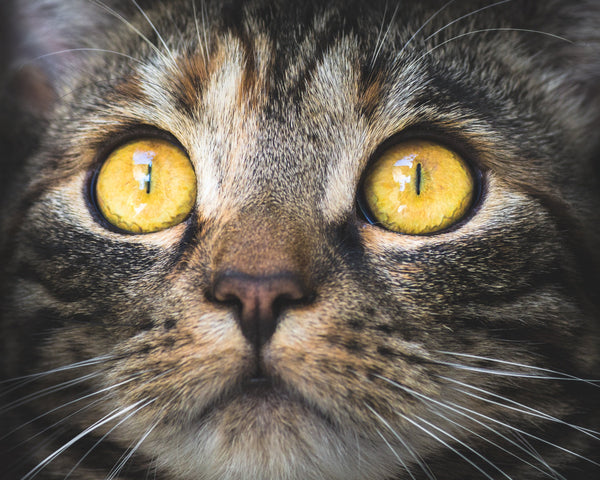
Eyes
Slow blinking: If you notice your cat slowly blinking at you, she’s ready to come over and socialize. "She’s showing friendliness and a relaxed state,” Krieger says. “If you slow blink back at her, it communicates non-aggression and friendliness.”
Dilated pupils: Whether your bonded cats are chasing each other or preparing to viciously attack a toy, dilated pupils are a sure sign of feline excitement. However, if big, wide pupils are combined with defensive or aggressive gestures or sounds, it can mean your cat is surprised or scared. Eyes dilate in low light. So, available light should also be taken into consideration.
Slit pupils: While your cat’s pupils will constrict in bright light, slit pupils might mean she’s feeling tense or aggressive.
Half closed: If your cat is relaxed or extremely happy, she’ll half-close or even entirely shut her eyes. It’s the ultimate sign of trust.
Ears
Ears forward: An interested and curious cat’s ears will point up and be positioned slightly forward.
Ears straight up: When your kitty’s ears stand at attention, he’s alert or curious.
Ears sideways and partially flattened: His ears indicate that he’s irritated, anxious, or frightened.
Ears turned back or flat: When your cat has "airplane ears", it’s a sure sign that he’s angry, irritable, or frightened. He may act aggressively.
Whiskers
Whiskers (or vibrissae) are the first hairs to develop in the womb. They’re two to three times thicker than normal fur and are embedded three times deeper into the skin — where they’re attached to nerves and blood vessels. Their tips are equipped with sensory organs called proprioceptors that help your cat sense the presence, size, and shape of nearby objects without seeing or touching them.
Because your cat’s eyes are so large, he can’t focus on anything less than a foot in front of him — but his whiskers are like little fingers that outline his prey’s body. “Whiskers help your cat hunt by determining where to bite,” Krieger says. (Sorry, birds and mice.)
Wondering what kind of mood your cat is in? If his whiskers are sticking out sideways, he’s relaxed. If they’re pushed forward and fanned out, he’s stimulated and engaged, and if they’re flattened against his cheeks, he’s fearful, anxious, or scared.
Kneading
When your cat rhythmically pushes her paws in and out against your lap — she’s likely purring. Loudly. She might even drool a little (although she’d never admit it). She’s feeling the love, so "making biscuits” might be her way of helping you feel it too. Kittens instinctively knead when they’re nursing to help stimulate their mothers' milk. Even if your cat is fully-grown, she might still enjoy that comforting, "food-is-love" feeling.
Exposed Belly
This means your cat completely trusts you. He feels comfortable enough to reveal his most vulnerable area to you. Dare to go in for a belly rub? There’s a 99% chance you’ll get your hand scratched. “All weapons are on display and waiting to be deployed,” Krieger says. We know, it’s a cute trap that's hard to resist.
Rubbing
When your cat rubs her cheek and head against you, she’s telling you that she loves you, right? Well, sort of. Your cat has scent glands around her mouth, on her cheeks, and forehead. Her unique scent, blended with yours and the scents of other household members, is also like a membership ID card. When she rubs against you, she’s claiming you as part of her family and her turf. Basically, she’s saying she cares — enough to tell the rest of the feline world to keep their paws off you.
Arched Back
If your cat gets near you and arches his back, he’s trying to tell you to pet him. If you scratch by the base of his tail (or along his spine), he may lift his rear end. Because he can transfer his scent using his anal glands, he’s inviting you to confirm his identity as a member of the family and exchange scents.
Curled Up
When your cat is curled up with her tail in a graceful swoop around her body and her head is tucked in toward her chest, she feels calm and secure because her vital organs are protected. She’s also minimizing her heat loss. While she may not be worried about a rival animal sneaking up on her in her sleep, she usually wants to be left alone.
Licking You
"When your cat licks you, he’s allogrooming — essentially mixing his scent with yours," Krieger says. "Allowgrooming is one way that cats identify family members and friends — they all carry the same familial scent."
Butt Wiggling
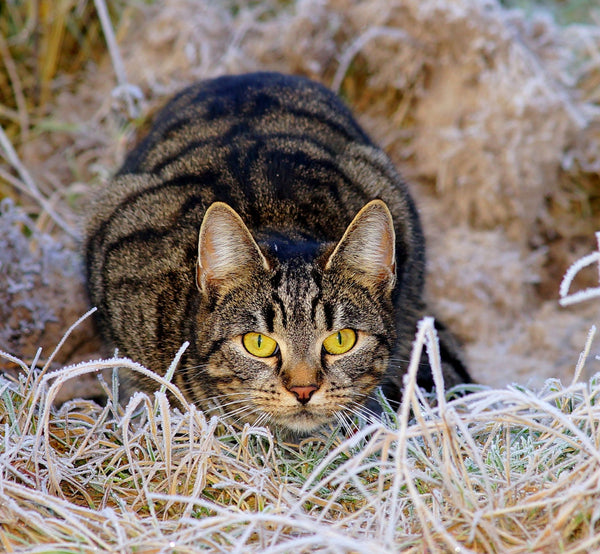
Nope, your cat probably isn’t a Miley Cyrus megafan. Her twerk-like shimmy is an aerobic warm-up, of sorts. She’s wiggling her hind end back and forth to check her balance. Or she may be excited by the thrill of the hunt.
Vocalizations: Your Cat Has Something to Say
Your cat can make several different sounds, whether he’s telling you it's time to get up (at least in his opinion) or feeling threatened, such as:

Meowing
Here are the most common types of meows...conveniently translated to human, of course.
- Short, high-pitched meow: standard greeting. “How ya doin'?"
- Several short meows at once: excited greeting. “I’m so happy to see you!”
- Mid-pitched, pleading meow: “I’m so bored, so I’ll be a super-cute suck up. How can you resist playing with me right away?”
- Drawn out or low meow: “My food bowl is only ¾ full, my water is missing a sip, my litter box has three lumps in it. Are you thinking about sitting down, human? Think again."
Trilling
A sound somewhere in between a meow and a purr, a trill means your cat wants you to follow him, usually to his food bowl. Have more than one cat? You’ll often hear them talk with each other this way.
Chattering
Chattering is the noise your cat makes when he’s perched in the window watching birds or squirrels. He usually chatters the most when his target is just out of reach. He may be expressing his irritation at not being able to hunt that pesky-but-mouthwatering bird. His chattering also might be an expression of excitement about spotting his next “toy” (or maybe his next “meal” if he’s a community cat). Some cat behaviorists believe that chattering is similar to a cat's "killing bite". When a cat hunts, he’ll grab his prey by the neck and snap its bones.
Purring
Your cat was born deaf and blind. “When the mom purrs, kittens feel the vibration that guides them to their first meal,” Krieger says. “Since the vibrations of purrs can’t be detected as readily as vocalizations, it’s also harder for predators to find the newborns.” Your cat will purr when he’s happy, even when he’s eating. “Sometimes cats who are ill or hurt will purr. It’s postulated that purring releases endorphins or “feel-good hormones” and may aid in the healing process,” she says.
Yowling
Sounding like a cross between a yodel and a howl, this particular feline sound means your cat is in some kind of distress — locked out, looking for you, or in pain. Find your cat if he’s making this noise. Although yowling is a mating call that’s usually reserved for cats in heat, senior cats may yowl if they’re lost or suffering from dementia.
Growling and hissing
"Growling and hissing are warnings," Krieger says. "If your cat is growling or hissing, leave him alone. Otherwise, he might lash out."
Soundless meowing
Being the recipient of “silent meows” will turn you into putty in your cat’s paws. But are they actually voiceless valentines? Probably not. While your kitty could be excited to see you, he might just want to sunbathe in the garden...again. After an “intense day” of bird watching, a silent meow could mean you need to turn down the noise. (Thought your cat just woke up? Remember he can snooze 12 to 16 hours per day.) Sometimes, silent meows are a sign of exhaustion or hunger and dehydration.
